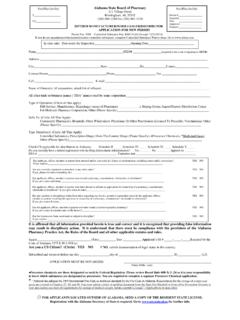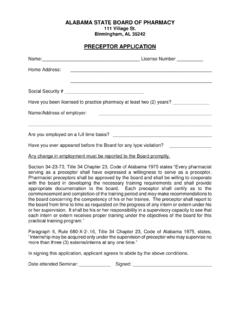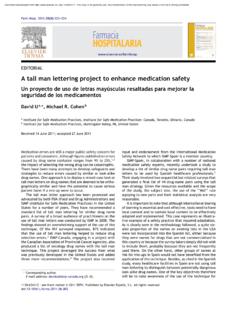Transcription of May 2014 News Alabama State Board of Pharmacy - …
1 AL Vol. 32, No. 3 Page 1 Continued on page 4 New Alabama Legislation Gives Controlled drug Prescribing Authority to Certified Nurse Practitioners and MidwivesAccording to the Alabama Board of Medical Examiners & Medical Licensure Commission of Alabama , The Alabama Legislature has passed Act 2013-223 which confers to Certified Registered Nurse Prac-titioners and Certified Nurse Midwives authority to prescribe controlled substances in Schedules, III, IV, and V. The [ Alabama Medical] Board will act as the certifying Board and issue Qualified Alabama Controlled Substances (QACSC) certificates in much the same way that Physician Assistants are issued QACSCs, that is, a CRNP/CNM in a collabora-tive agreement with a physician may apply for a QACSC to prescribe controlled substances in Schedules III, IV and V without a collaborating physician s review or signature, provided such is agreed to in the col-laborative practice agreement.
2 Beginning October 1, 2013, applicants may apply for a QACSC. To qualify for a QACSC, a certified registered nurse practitioner (CRNP) or certified nurse midwife (CNM) must: Be in a collaborative practice with a physician who holds a valid, unrestricted Alabama Controlled Substances Certificate. Submit documentation of attendance at an eight-credit, Board -approved course entitled, Prescribing Controlled Drugs, plus attendance at four credits of advanced pharmacology and controlled substance (CS) prescribing trends. These courses became available this past summer for those interested. Provide documentation of a minimum of 12 months of active clinical practice pursuant to an approved collaborative. Once the required information is submitted to the Alabama Medical Board , the applicant must submit a form to drug Enforcement Admin-istration (DEA).
3 DEA will confirm with the Alabama Medical Board that the person is approved for authority to prescribe CS and will provide the nurse with a DEA number. Look for the nurse s DEA number on prescriptions you receive from the nurse. Unlike physician assistants, no limitations were legislated on the prescribing rights of CRNPs or CNMs. There is not a limit for the number of doses prescribed or the number of refills allowed other than those already in the law for Mail Order Prescriptions (Amended)(1) E very applicant for a Mail Order Permit or Permits pursuant to the provisions of Code of Alabama 1975, 34-23-30, 34-23-31, shall obtain a permit biennially. On the first registration by a Pharmacy located outside of the State of Alabama , the provi-sions of Code of Alabama 1975, 34-23-30 shall apply to such first registration.
4 (2) Registration. No Nonresident Pharmacy shall ship, mail or de-liver prescription drugs and/or devices to a patient in this State unless registered by the Alabama State Board of Pharmacy . (3) A gent of Record. Each Nonresident Pharmacy that ships, mails, or delivers prescription drugs and/or devices to a patient in the State of Alabama shall designate a resident agent in Alabama for service of process. Any such Nonresident Pharmacy that does not so designate a registered agent and that ships, mails or deliv-ers prescription drugs and/or devices in the State of Alabama shall be deemed an appointment by such Nonresident Pharmacy of the Secretary of State to be its true and lawful attorney upon whom may be served all legal process in any action or proceed-ings against such Pharmacy growing out of or arising from such delivery.
5 A copy of any such service of process shall be mailed to the Nonresident Pharmacy by the complaining party by certified mail, return receipt requested, postage prepaid, at the address of such Nonresident Pharmacy as designated on the Pharmacy s application for registration in this State . If any such Pharmacy is not licensed in this State , service on the Secretary of State of Alabama only shall be sufficient service.(4) Conditions of Registration. As conditions of receiving a per-mit, the Nonresident Pharmacy or a renewal if applicable must comply with the following:(a) Be registered and in a good standing in the State in which such Pharmacy is located; (b) Maintain, in readily retrievable form, records of legend drugs and/or devices dispensed to Alabama patients;(c) Supply upon request, all information needed by the Alabama Board of Pharmacy to carry out the Board s responsibilities under the statutes and regulations per-taining to Nonresident Pharmacies;(d) Maintain Pharmacy hours that permit the timely dis-pensing of drugs to Alabama patients and provide rea-sonable access for the Alabama patients to consult with a licensed pharmacist about such patients medications.
6 (e) Provide toll-free telephone communication consulta-tion between an Alabama patient and a pharmacist at the Pharmacy who has access to the patient s records, and ensure that said telephone number(s) will be placed upon the label affixed to each legend drug container;.(f) Designate a supervising pharmacist who shall be li-censed by the Alabama State Board of Pharmacy . The supervising pharmacist shall be responsible for ensuring that the holder of the permit referenced herein complies with the requirements of this rule and all applicable statutory provisions and rules. (g) If there is a change of the designated Supervising Phar-macist, the permit holder shall notify the Board by filing the Notice of Change of Supervising Pharmacist form provided by the Board . If the permit holder is un-111 Village St Hoover, AL 35242 Tel: 205/981-2280 Fax: 205/981-2330 May 2014 Published to promote compliance of Pharmacy and drug lawNewsAlabama StateBoard of Pharmacyit as Benadryl and placed a bottle of diphenhydramine in the bag for pick-up.
7 Around this same time, the Pharmacy went through a change in wholesaler and many manufacturers of generic products were changed. A few days later, a coworker of the patient picked up the medication (along with several others). The technician at the point-of-sale told the coworker that many of the manufacturers had changed recently and that some of the pills may look different. The patient received the diphenhydramine, filled her medication box with the capsules, and took diphenhydramine daily for three weeks before noticing she was unusually tired. When she brought the bottle back to the Pharmacy , the error was continues to receive reports of confused drug name pairs being involved in errors. ISMP wants to inform its readers of these drug name confusions so they may continue evaluating what measures they have in place to protect against these possible Help Is Needed With Product Safety Testing.
8 If you are a pharmacist, nurse, Pharmacy technician, or other health care prac-titioner who is interested in furthering medication safety and error prevention, you can make a difference! Med-ERRS (a subsidiary of ISMP) is looking for assistance to help evaluate medication labels, drug packaging, and proposed drug names prior to submission by pharmaceutical and biotech companies for approval by Food and drug Administration (FDA). The process is fun, simple, and easy. A small honorarium is paid. For more information or to sign up, visit and click on Become a Reviewer. FDA Issues Alert on Acetaminophen Products In light of all the recent news alerts and warnings about the use of acetaminophen and acetaminophen-containing products, FDA issued a recommendation of importance to pharmacists, prescrib-ers, and recommends that health care providers consider prescrib-ing combination drug products that contain 325 mg or less of acetaminophen.
9 FDA also recommends that when a pharmacist receives a prescription for a combination product with more than 325 mg of acetaminophen per dosage unit that he or she contacts the prescriber to discuss a product with a lower dose of acetamino-phen. A two-tablet or two-capsule dose may still be prescribed, if appropriate. In that case, the total dose of acetaminophen would be 650 mg (the amount in two 325 mg dosage units). When making individual dosing determinations, health care providers should always consider the amounts of both the acetaminophen and the opioid components in the prescription combination drug , in its MedWatch Safety Alert, reports that, There are no available data to show that taking more than 325 mg of acetamino-phen per dosage unit provides additional benefit that outweighs the added risks for liver injury.
10 Further, limiting the amount of acetaminophen per dosage unit will reduce the risk of severe liver injury from inadvertent acetaminophen overdose, which can lead to liver failure, liver transplant, and death. In January 2011, FDA asked manufacturers of prescription combination drug products containing acetaminophen to limit the amount of acetaminophen to no more than 325 mg in each tablet or capsule by January 14, 2014. FDA requested this action to protect consumers from the risk of severe liver damage that Page 2 National Pharmacy Compliance News(Applicability of the contents of articles in the National Pharmacy Compliance News to a particular State or jurisdiction should not be assumed and can only be ascertained by examining the law of such State or jurisdiction.)













